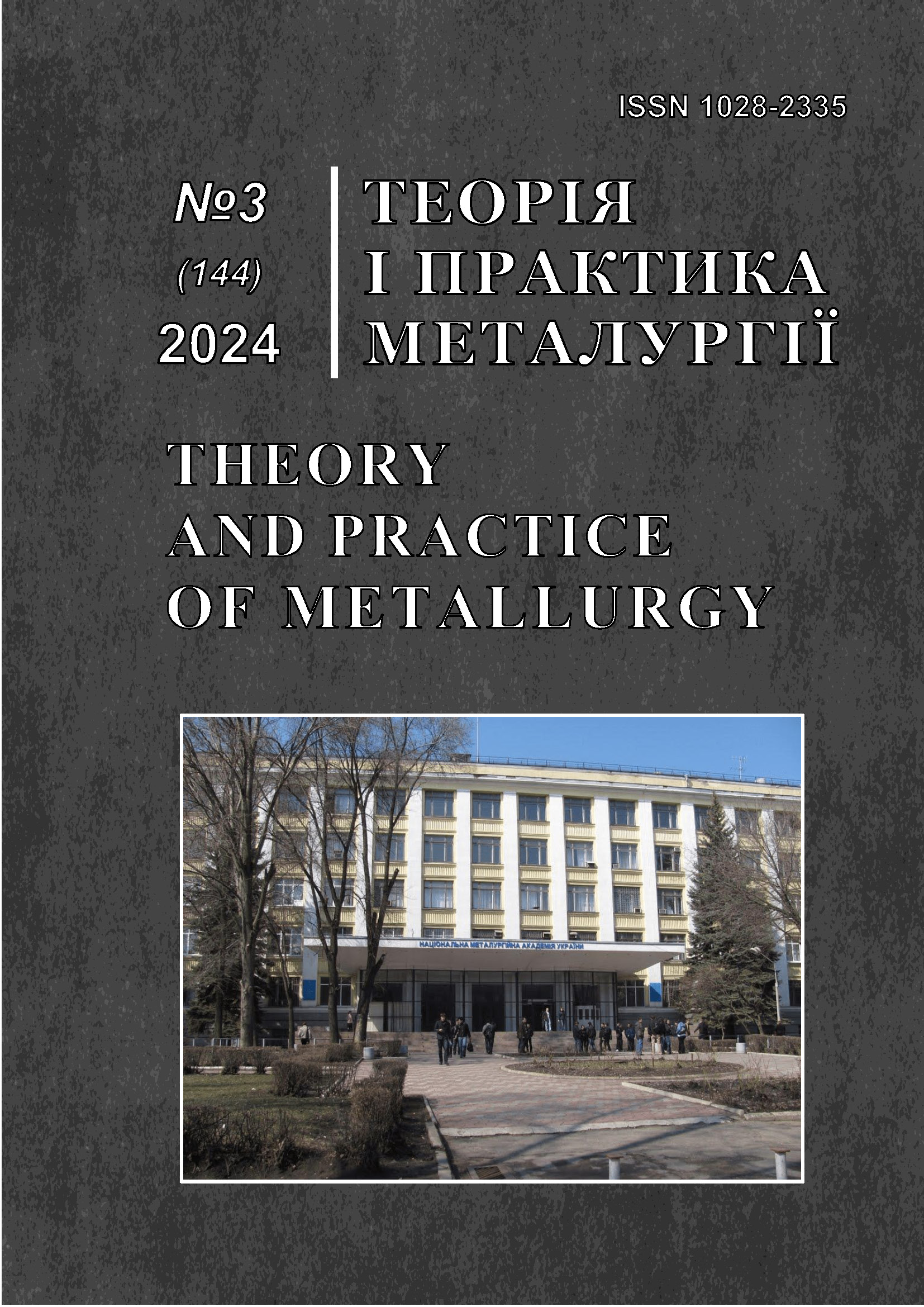Development of a “passive” cut-off system of final bof slag and prodused of functional stopers
DOI:
https://doi.org/10.15802/tpm.3.2024.07Keywords:
bof, slag, primary cut-off system, secondary cut-off system, stopper, tamponAbstract
One of the main tools for improving the quality of produced metal products is operations to detect and cut-off slag during the technological metal transfer from BOF to the ladle. According to estimates from various researchers and practical experience, the amount of slag entering the ladle during the tapping is distributed as follows: up to 25% - at the beginning, up to 60% - at the end of the tapping and up to 15% - when the converter returns to its working position. Today, there are two basic schemes for cutting off converter slag: automatic (“active”) and “passive”. The main automatic schemes include a “gas-dynamic” cut-off system and a “slide gate” type system. An affordable and effective alternative is the scheme of “passive”, primary and secondary BOF slag cut-off system, using functional refractory devices. At the industrial facilities of GIR-Engineering LLC, together with PTIMA NAS of Ukraine, has developed a "passive" scheme for the complex BOF slag cut-off system. It includes two systems, primary cut-off with a plastic “tampon” type stopper and secondary cut-off with the refractory “ball” / “dart” type stopper. Both systems work with manual applicators, which minimizes the capital costs of introducing them into the production chain. During the period from July 2020 to September 2020, successful experimental and pilot-industrial tests of primary cut-off slag stoppers “tampon” type, “GIR-TAMP-150-DMK” brand, were carried out in steelmaking shop of PrJSC “KAMET-STAL” (Kamianske, Ukraine) consisting of two 250-ton capacity BOF units. The average rephosphorization rate using the developed products was reduced by 20%. During 2021-2024 years, at the PrJSC " KAMET-STAL" plant, successful industrial tests of the developed complex BOF slag cut-off system were carried out. The total economic effect from implementation was ≈ 1.2 USD per ton of steel.
References
Pistorius, P. C. (2019). Slag carry-over and the production of «clean» steel. J. S. Afr. Inst. Min. Metall., 119(6), 557−561. http://dx.doi.org/10.17159/2411-9717/kn01/2019
Steneholm, K., Andersson, N. A. I., Tilliander, A., & Jönsson, P. G. (2018). The role of process control on the steel cleanliness. Ironmaking & Steelmaking, 45(2), 114-124. http://doi.org/10.1080/03019233.2016.1245917
Kamaraj, A., Mandal, G. K., Shanmugam, S. P., & Roy, G. G. (2022). Quantification and analysis of slag carryover during liquid steel tapping from BOF vessel. Can. Metall. Q., 61(2), 202−215. https://doi.org/10.1080/00084433.2022.2044688
Brämming, M., Björkman, B., & Samuelsson, C. (2016). BOF process control and slopping prediction based on multivariate data analysis. Steel Res. Int., 87(3), 301−310. https://doi.org/10.1002/srin.201500040
Zhang, Z., Bin, L., & Jiang, Y. (2014). Slag detection system based on infrared temperature measurement. Optik, 125(3), 1412−1416. https://doi.org/10.1016/j.ijleo.2013.08.016
Patra, P., Sarkar, A., & Tiwari, A. (2019). Infrared-based slag monitoring and detection system based on computer vision for basic oxygen furnace. Ironmaking & Steelmaking, 46(7), 692−697. https://doi.org/10.1080/03019233.2018.1460909
Zhang, Z., Li, Q., & Yan, L. (2015). Slag detection system based on infrared thermography in steel making industry. Recent Pat. Signal Process., 5(1), 16−23. https://doi.org/10.2174/2210686305666150930230548
Usamentiaga, R., Molleda, J., Garcia, D. F., Granda, J. C., & Rendueles, J. L. (2012). Temperature measurement of molten pig iron with slag characterization and detection using infrared computer vision. IEEE Trans. Instrum. Meas., 61(5), 1149−1159. https://doi.org/10.1109/TIM.2011.2178675
Chakraborty, B., & Sinha, K. (2011). Development of caster slag detection system through imaging technique. Int. J. Instrum. Technol., 1(1), 84−91. https://doi.org/10.1504/IJIT.2011.043599
Wu F., & Wang Y. (2005). A method for detecting the slag transferring from ladle to tundish based on video system. Ind. Control Comput., 18, 38−47
Eysn, M. (1983). Pneumatic slag stopper for oxygen converters. Iron and Steel Engineer, (10), 53 – 55
Howanski, W. S., Kalep, T., Swift, T. (2006). Optimizing BOF slag control through the application of refractory darts. Iron Steel Technol., 3, 36−43
Lee, S. J., Kim, S. J. & Lee, H. G. (2016). New idea of suppressing free surface vortex during tapping liquid steel from converter. Met. Mater. Int., 22, 136–142. https://doi.org/10.1007/s12540-015-5428-0
Chunkhuei, Ch., Khueifen, L., Tszianchzhun, Ch., & Tsiuan, Kh. (2006). Probka konverternoho shlaku. (Patent No. 2795226). China
Kamaraj, A., Mandal, G. K., & Roy, G. G. (2019). Control of slag carryover from the BOF vessel during tapping: BOF cold model studies. Metall. Mater. Trans. B, 50, 438–458. https://doi.org/10.1007/s11663-018-1432-3
Kamaraj, A., Roy, G. G., & Mandal, G. K. (2017). Modeling and Simulation Studies on BOF Tapping Process. In 3rd Internation Conference of Ironmaking and Steelmaking, Kanpur, pp. 403–406
Nemsadze, H. H., Sharandin, K. M., Smirnov, O. M., Dzhodzhua, R. A., & Riabyi, D. V. (2023). Sposib vidsichennia kintsevoho konverternoho shlaku pry vypusku plavky cherez lotku konvertera. (Patent application No. a202303647). https://sis.nipo.gov.ua/uk/search/detail/1752362/
Nemsadze, H. H., Sharandin, K. M., Smirnov, O. M., Dzhodzhua, R. A., & Riabyi, D. V. (2023). Prystrii dlia vidsichennia kintsevoho konverternoho shlaku pry vypusku plavky cherez lotku konvertera. (Patent application No. a202303358)
Downloads
Published
How to Cite
Issue
Section
License
Copyright (c) 2024 Kamkina L.V., Smirnov O.M., Sharandin K.M., Ryabyi D.V.

This work is licensed under a Creative Commons Attribution 4.0 International License.
Authors retain copyright of the published papers and grant to the publisher the non-exclusive right to publish the article, to be cited as its original publisher in case of reuse, and to distribute it in all forms and media. Articles will be distributed under the Creative Commons Attribution 4.0 International (CC BY 4.0) licence.
Authors can enter the separate, additional contractual arrangements for non-exclusive distribution of the published paper (e.g., post it to an institutional repository or publish it in a book), with an acknowledgement of its initial publication in this journal.




